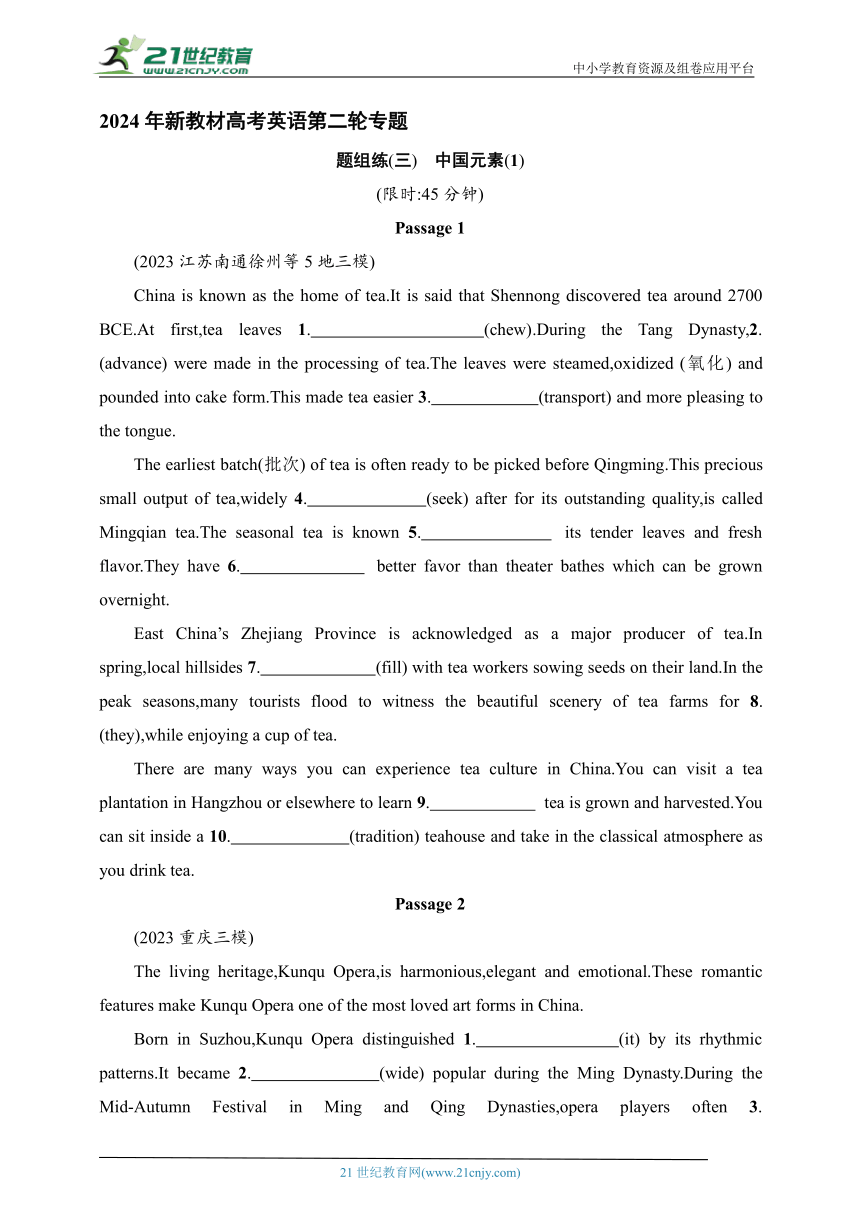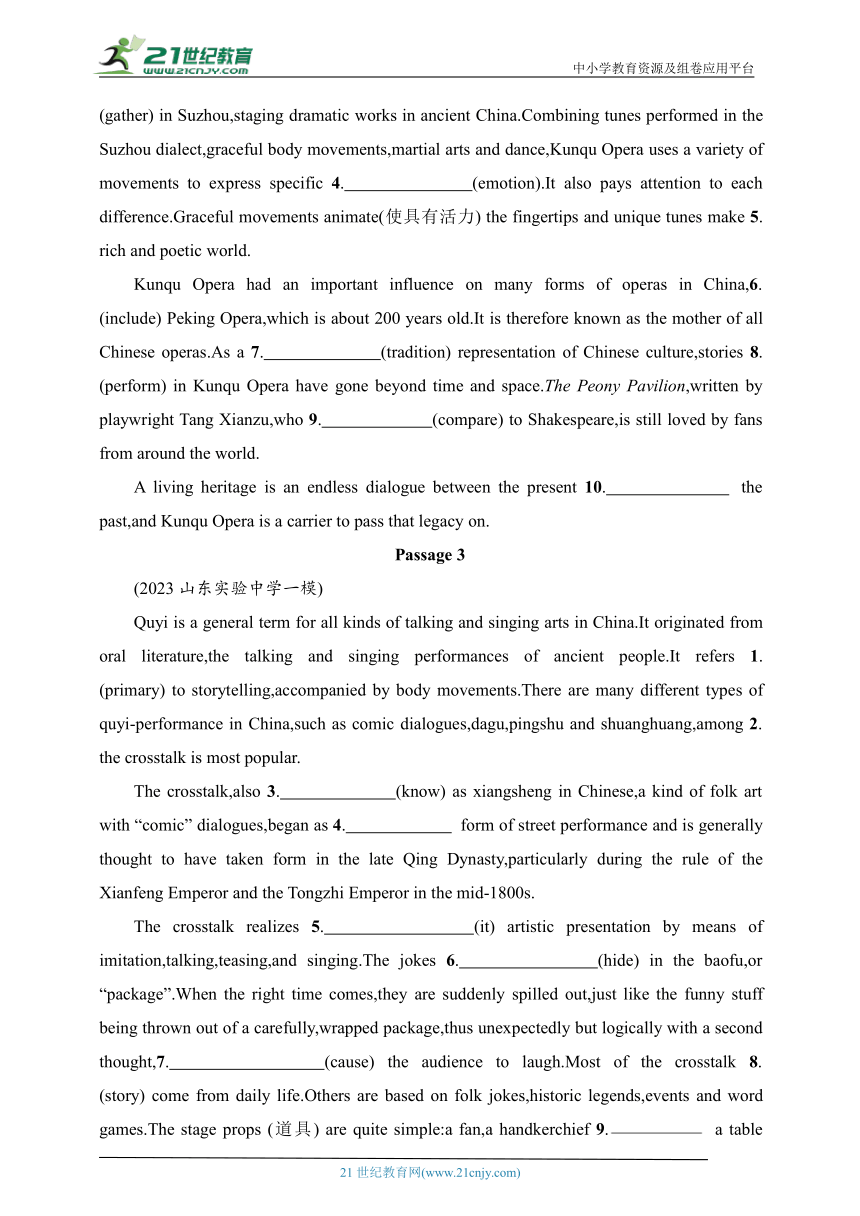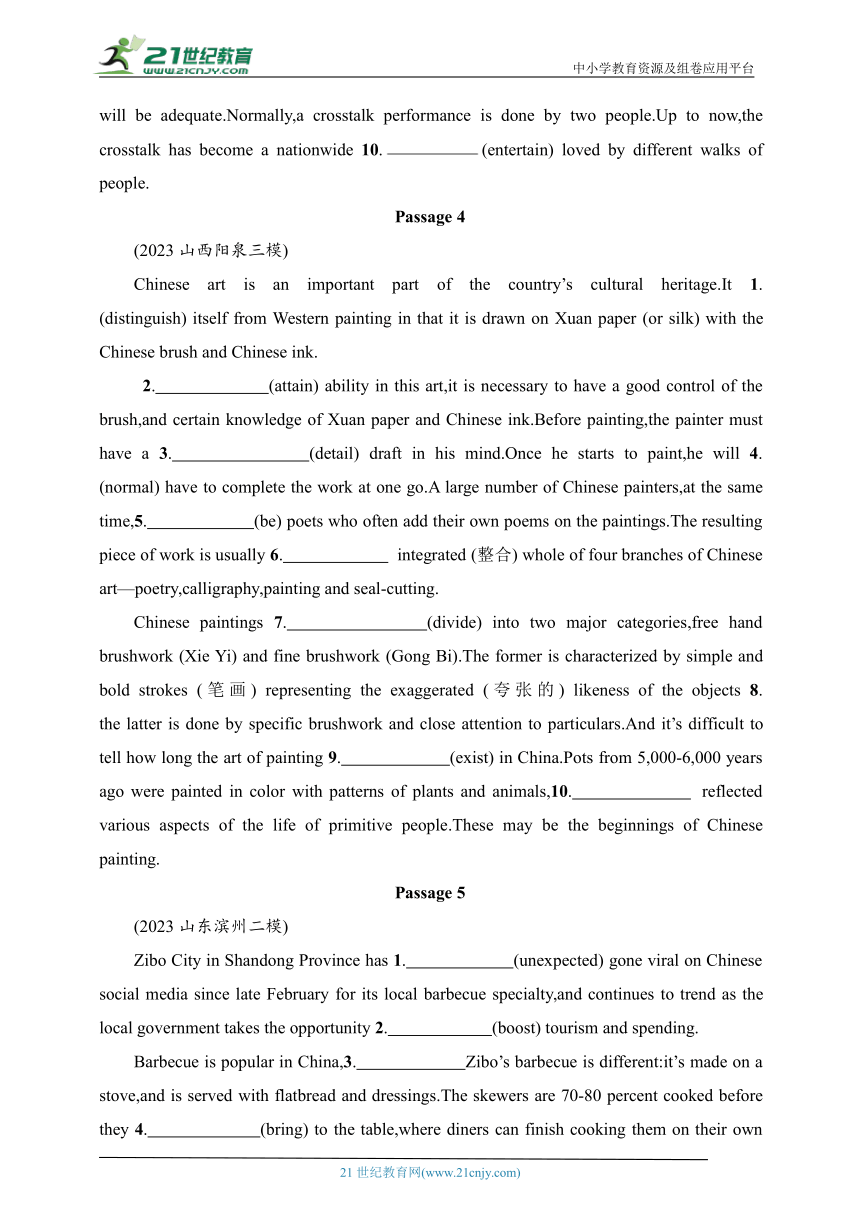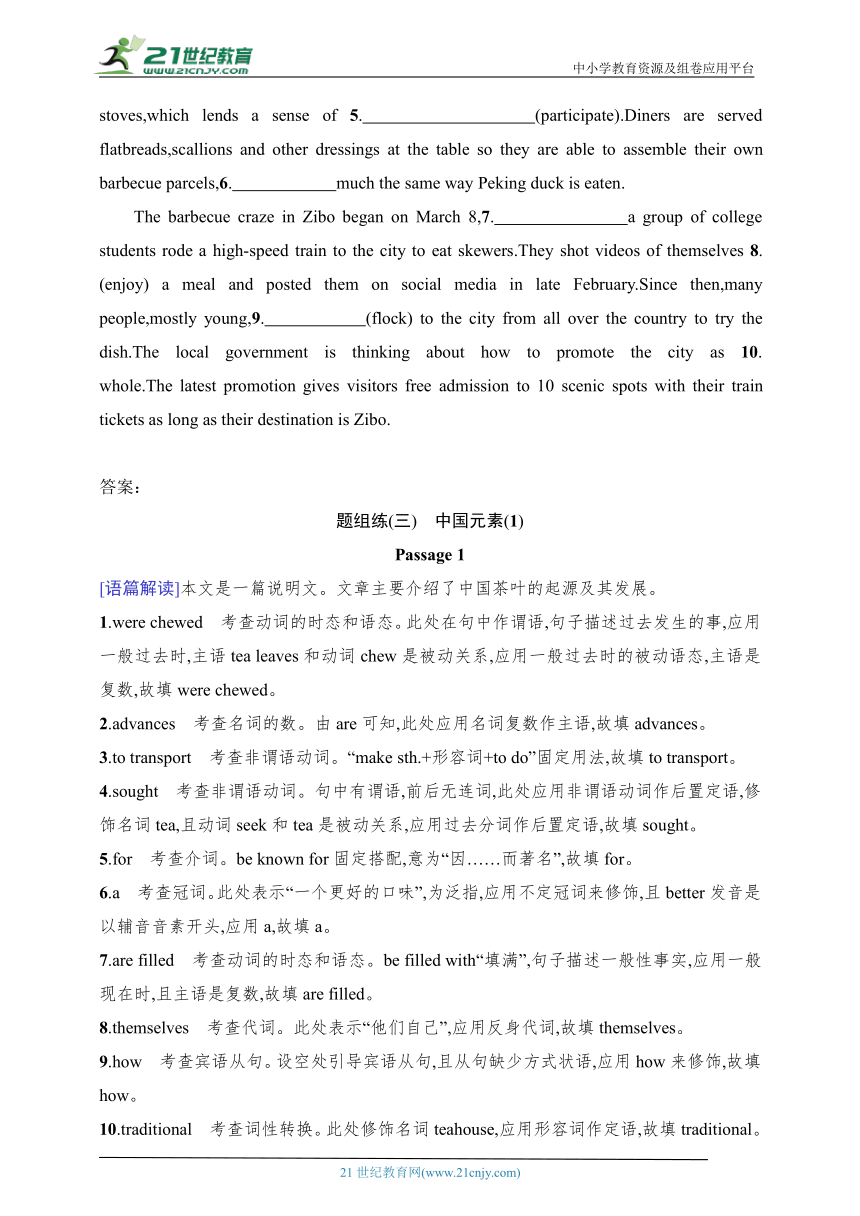2024年新教材高考英语第二轮专题练习--语篇填空 题组练3 中国元素(1)(答案与解析)
文档属性
| 名称 | 2024年新教材高考英语第二轮专题练习--语篇填空 题组练3 中国元素(1)(答案与解析) |  | |
| 格式 | docx | ||
| 文件大小 | 1.0MB | ||
| 资源类型 | 试卷 | ||
| 版本资源 | 通用版 | ||
| 科目 | 英语 | ||
| 更新时间 | 2023-10-25 15:36:30 | ||
图片预览




文档简介
中小学教育资源及组卷应用平台
2024年新教材高考英语第二轮专题
题组练(三) 中国元素(1)
(限时:45分钟)
Passage 1
(2023江苏南通徐州等5地三模)
China is known as the home of tea.It is said that Shennong discovered tea around 2700 BCE.At first,tea leaves 1. (chew).During the Tang Dynasty,2. (advance) were made in the processing of tea.The leaves were steamed,oxidized (氧化) and pounded into cake form.This made tea easier 3. (transport) and more pleasing to the tongue.
The earliest batch(批次) of tea is often ready to be picked before Qingming.This precious small output of tea,widely 4. (seek) after for its outstanding quality,is called Mingqian tea.The seasonal tea is known 5. its tender leaves and fresh flavor.They have 6. better favor than theater bathes which can be grown overnight.
East China’s Zhejiang Province is acknowledged as a major producer of tea.In spring,local hillsides 7. (fill) with tea workers sowing seeds on their land.In the peak seasons,many tourists flood to witness the beautiful scenery of tea farms for 8. (they),while enjoying a cup of tea.
There are many ways you can experience tea culture in China.You can visit a tea plantation in Hangzhou or elsewhere to learn 9. tea is grown and harvested.You can sit inside a 10. (tradition) teahouse and take in the classical atmosphere as you drink tea.
Passage 2
(2023重庆三模)
The living heritage,Kunqu Opera,is harmonious,elegant and emotional.These romantic features make Kunqu Opera one of the most loved art forms in China.
Born in Suzhou,Kunqu Opera distinguished 1. (it) by its rhythmic patterns.It became 2. (wide) popular during the Ming Dynasty.During the Mid-Autumn Festival in Ming and Qing Dynasties,opera players often 3. (gather) in Suzhou,staging dramatic works in ancient bining tunes performed in the Suzhou dialect,graceful body movements,martial arts and dance,Kunqu Opera uses a variety of movements to express specific 4. (emotion).It also pays attention to each difference.Graceful movements animate(使具有活力) the fingertips and unique tunes make 5. rich and poetic world.
Kunqu Opera had an important influence on many forms of operas in China,6. (include) Peking Opera,which is about 200 years old.It is therefore known as the mother of all Chinese operas.As a 7. (tradition) representation of Chinese culture,stories 8. (perform) in Kunqu Opera have gone beyond time and space.The Peony Pavilion,written by playwright Tang Xianzu,who 9. (compare) to Shakespeare,is still loved by fans from around the world.
A living heritage is an endless dialogue between the present 10. the past,and Kunqu Opera is a carrier to pass that legacy on.
Passage 3
(2023山东实验中学一模)
Quyi is a general term for all kinds of talking and singing arts in China.It originated from oral literature,the talking and singing performances of ancient people.It refers 1. (primary) to storytelling,accompanied by body movements.There are many different types of quyi-performance in China,such as comic dialogues,dagu,pingshu and shuanghuang,among 2. the crosstalk is most popular.
The crosstalk,also 3. (know) as xiangsheng in Chinese,a kind of folk art with “comic” dialogues,began as 4. form of street performance and is generally thought to have taken form in the late Qing Dynasty,particularly during the rule of the Xianfeng Emperor and the Tongzhi Emperor in the mid-1800s.
The crosstalk realizes 5. (it) artistic presentation by means of imitation,talking,teasing,and singing.The jokes 6. (hide) in the baofu,or “package”.When the right time comes,they are suddenly spilled out,just like the funny stuff being thrown out of a carefully,wrapped package,thus unexpectedly but logically with a second thought,7. (cause) the audience to laugh.Most of the crosstalk 8. (story) come from daily life.Others are based on folk jokes,historic legends,events and word games.The stage props (道具) are quite simple:a fan,a handkerchief 9. a table will be adequate.Normally,a crosstalk performance is done by two people.Up to now,the crosstalk has become a nationwide 10.(entertain) loved by different walks of people.
Passage 4
(2023山西阳泉三模)
Chinese art is an important part of the country’s cultural heritage.It 1. (distinguish) itself from Western painting in that it is drawn on Xuan paper (or silk) with the Chinese brush and Chinese ink.
2. (attain) ability in this art,it is necessary to have a good control of the brush,and certain knowledge of Xuan paper and Chinese ink.Before painting,the painter must have a 3. (detail) draft in his mind.Once he starts to paint,he will 4. (normal) have to complete the work at one go.A large number of Chinese painters,at the same time,5. (be) poets who often add their own poems on the paintings.The resulting piece of work is usually 6. integrated (整合) whole of four branches of Chinese art—poetry,calligraphy,painting and seal-cutting.
Chinese paintings 7. (divide) into two major categories,free hand brushwork (Xie Yi) and fine brushwork (Gong Bi).The former is characterized by simple and bold strokes (笔画) representing the exaggerated (夸张的) likeness of the objects 8. the latter is done by specific brushwork and close attention to particulars.And it’s difficult to tell how long the art of painting 9. (exist) in China.Pots from 5,000-6,000 years ago were painted in color with patterns of plants and animals,10. reflected various aspects of the life of primitive people.These may be the beginnings of Chinese painting.
Passage 5
(2023山东滨州二模)
Zibo City in Shandong Province has 1. (unexpected) gone viral on Chinese social media since late February for its local barbecue specialty,and continues to trend as the local government takes the opportunity 2. (boost) tourism and spending.
Barbecue is popular in China,3. Zibo’s barbecue is different:it’s made on a stove,and is served with flatbread and dressings.The skewers are 70-80 percent cooked before they 4. (bring) to the table,where diners can finish cooking them on their own stoves,which lends a sense of 5. (participate).Diners are served flatbreads,scallions and other dressings at the table so they are able to assemble their own barbecue parcels,6. much the same way Peking duck is eaten.
The barbecue craze in Zibo began on March 8,7. a group of college students rode a high-speed train to the city to eat skewers.They shot videos of themselves 8. (enjoy) a meal and posted them on social media in late February.Since then,many people,mostly young,9. (flock) to the city from all over the country to try the dish.The local government is thinking about how to promote the city as 10. whole.The latest promotion gives visitors free admission to 10 scenic spots with their train tickets as long as their destination is Zibo.
答案:
题组练(三) 中国元素(1)
Passage 1
[语篇解读]本文是一篇说明文。文章主要介绍了中国茶叶的起源及其发展。
1.were chewed 考查动词的时态和语态。此处在句中作谓语,句子描述过去发生的事,应用一般过去时,主语tea leaves和动词chew是被动关系,应用一般过去时的被动语态,主语是复数,故填were chewed。
2.advances 考查名词的数。由are可知,此处应用名词复数作主语,故填advances。
3.to transport 考查非谓语动词。“make sth.+形容词+to do”固定用法,故填to transport。
4.sought 考查非谓语动词。句中有谓语,前后无连词,此处应用非谓语动词作后置定语,修饰名词tea,且动词seek和tea是被动关系,应用过去分词作后置定语,故填sought。
5.for 考查介词。be known for固定搭配,意为“因……而著名”,故填for。
6.a 考查冠词。此处表示“一个更好的口味”,为泛指,应用不定冠词来修饰,且better发音是以辅音音素开头,应用a,故填a。
7.are filled 考查动词的时态和语态。be filled with“填满”,句子描述一般性事实,应用一般现在时,且主语是复数,故填are filled。
8.themselves 考查代词。此处表示“他们自己”,应用反身代词,故填themselves。
9.how 考查宾语从句。设空处引导宾语从句,且从句缺少方式状语,应用how来修饰,故填how。
10.traditional 考查词性转换。此处修饰名词teahouse,应用形容词作定语,故填traditional。
Passage 2
[语篇解读]本文是一篇说明文。文章主要介绍了中国昆曲。
1.itself 考查反身代词。设空处的代词指的就是本句主语Kunqu Opera,主语与宾语指代相同,用其相应的反身代词作宾语。故填itself。
2.widely 考查词性转换。设空处修饰popular这个形容词,应用副词形式。故填widely。
3.gathered 考查动词时态。根据时间状语“During the Mid-Autumn Festival in Ming and Qing Dynasties”可知,句子描述过去发生的事情,用一般过去时。故填gathered。
4.emotions 考查名词复数。emotion作可数名词,前面无冠词修饰,应用复数形式表示泛指。故填emotions。
5.a 考查不定冠词。此处泛指“一个多彩且有诗意的世界”,应用不定冠词。故填a。
6.including 考查介词。分析句子可知,此处用介词在句中作状语。故填including。
7.traditional 考查形容词。设空处应用形容词作定语,修饰名词representation,故填traditional。
8.performed 考查非谓语动词。动词perform和stories之间是动宾关系,故用过去分词作后置定语,表示被动。故填performed。
9.is compared 考查动词的时态、语态和主谓一致。句子是讲述客观事实,关系代词who指代Tang Xianzu,表示单数意义,和动词compare之间是被动关系,故用一般现在时的被动语态,故填is compared。
10.and 考查连词。between...and...在……和……之间。故填and。
Passage 3
[语篇解读]本文是一篇说明文。文章主要介绍了相声这种艺术形式以及其特点。
1.primarily 考查词性转换。修饰动词refer应用副词作状语。故填primarily。
2.which 考查定语从句。此处为“介词+关系代词”结构的非限制性定语从句,修饰先行词types,作介词的宾语,指物,故填which。
3.known 考查非谓语动词。be known as“被称为”,此处为过去分词作后置定语,故填known。
4.a 考查冠词。form为泛指且发音以辅音音素开头,故填a。
5.its 考查代词。修饰名词presentation应用形容词性物主代词。故填its。
6.are hidden 考查动词的时态和语态。句意:这些笑话都藏在“包袱”里。主语与谓语构成被动关系,且陈述客观事实,所以用一般现在时的被动语态,主语为jokes,谓语用复数。故填are hidden。
7.causing 考查非谓语动词。分析句子结构可知cause与逻辑主语they构成主动关系,故用现在分词作状语。故填causing。
8.stories 考查名词的数。story为可数名词,结合上文Most of the crosstalk可知用复数形式。故填stories。
9.and 考查连词。前后文为并列关系,故填and。
10.entertainment 考查词性转换。此处作表语,根据不定冠词可知用单数名词。故填entertainment。
Passage 4
[语篇解读]本文是一篇说明文。文章主要介绍的是中国画。
1.distinguishes 考查动词的时态和主谓一致。通篇时态是一般现在时,主语It是单数,因此空格处是第三人称单数。故填distinguishes。
2.To attain 考查非谓语动词。分析句子结构可知,设空处表目的,应用动词不定式。位于句首,首字母大写,故填To attain。
3.detailed 考查词性转换。设空处作定语,修饰名词draft,用形容词。故填detailed。
4.normally 考查词性转换。设空处修饰have to complete,应用副词,故填normally。
5.are 考查动词的时态和主谓一致。通篇时态是一般现在时,主语painters是复数,因此设空处填are。
6.an 考查冠词。whole是名词,意为“整体”,是可数名词,且表泛指,前面需加不定冠词,integrated发音是以元音音素开头,故填an。
7.are divided 考查固定短语。根据语境可知,句子表示“中国画被分为两大类”,be divided into是固定短语,意为“被分为”,主语paintings是复数,通篇时态是一般现在时,故填are divided。
8.while/and 考查连词。由前面的“The former”和后面的“the latter”可知,前后两句是并列关系,故填while/and。
9.has existed 考查动词的时态和主谓一致。根据语境可知,句子表示“很难说绘画艺术在中国存在了多久”,设空处用现在完成时表示已经存在,主语the art of painting是单数,故填has existed。
10.which 考查定语从句的引导词。分析句子结构可知,设空处引导的是非限制性定语从句,从句中缺少主语,先行词是patterns of plants and animals,是物,故填which。
Passage 5
[语篇解读]本文是一篇新闻报道。文章主要介绍了淄博烧烤在中国社交媒体上意外走红,当地政府抓住机会促进旅游业和消费。
1.unexpectedly 考查词性转换。此处修饰动词短语gone viral,作状语,应用副词,故填unexpectedly。
2.to boost 考查非谓语动词。take the opportunity to do sth.抓住机会做某事,故填to boost。
3.but 考查连词。前后句子是转折关系,故填but。
4.are brought 考查动词的时态和语态。此处在before引导的状语从句中作谓语,主语they和动词bring为被动关系,且句子描述一般性事实,所以此处应用一般现在时的被动语态,故填are brought。
5.participation 考查词性转换。此处应用名词作宾语,故填participation。
6.in 考查介词。in much the same way几乎与……同样的方式,故填in。
7.when 考查定语从句。空处引导非限制性定语从句,修饰先行词March 8,且从句缺少时间状语,应用关系副词引导,故填when。
8.enjoying 考查非谓语动词。句中已有谓语动词,此处应用非谓语形式,且动词enjoy和themselves是逻辑上的主谓关系,应用现在分词表主动,故填enjoying。
9.have flocked/have been flocking 考查动词的时态。由since then可知,句子既可以用现在完成时,表示从过去到现在全国各地人蜂拥到这个地方,也可以用现在完成进行时,表示从过去到现在全国各地人蜂拥到这个地方,也有可能继续下去,强调动作的持续性,主语是复数,助动词应用have,故填have flocked/have been flocking。
10.a 考查冠词。as a whole整体上,故填a。
21世纪教育网 www.21cnjy.com 精品试卷·第 2 页 (共 2 页)
21世纪教育网(www.21cnjy.com)
2024年新教材高考英语第二轮专题
题组练(三) 中国元素(1)
(限时:45分钟)
Passage 1
(2023江苏南通徐州等5地三模)
China is known as the home of tea.It is said that Shennong discovered tea around 2700 BCE.At first,tea leaves 1. (chew).During the Tang Dynasty,2. (advance) were made in the processing of tea.The leaves were steamed,oxidized (氧化) and pounded into cake form.This made tea easier 3. (transport) and more pleasing to the tongue.
The earliest batch(批次) of tea is often ready to be picked before Qingming.This precious small output of tea,widely 4. (seek) after for its outstanding quality,is called Mingqian tea.The seasonal tea is known 5. its tender leaves and fresh flavor.They have 6. better favor than theater bathes which can be grown overnight.
East China’s Zhejiang Province is acknowledged as a major producer of tea.In spring,local hillsides 7. (fill) with tea workers sowing seeds on their land.In the peak seasons,many tourists flood to witness the beautiful scenery of tea farms for 8. (they),while enjoying a cup of tea.
There are many ways you can experience tea culture in China.You can visit a tea plantation in Hangzhou or elsewhere to learn 9. tea is grown and harvested.You can sit inside a 10. (tradition) teahouse and take in the classical atmosphere as you drink tea.
Passage 2
(2023重庆三模)
The living heritage,Kunqu Opera,is harmonious,elegant and emotional.These romantic features make Kunqu Opera one of the most loved art forms in China.
Born in Suzhou,Kunqu Opera distinguished 1. (it) by its rhythmic patterns.It became 2. (wide) popular during the Ming Dynasty.During the Mid-Autumn Festival in Ming and Qing Dynasties,opera players often 3. (gather) in Suzhou,staging dramatic works in ancient bining tunes performed in the Suzhou dialect,graceful body movements,martial arts and dance,Kunqu Opera uses a variety of movements to express specific 4. (emotion).It also pays attention to each difference.Graceful movements animate(使具有活力) the fingertips and unique tunes make 5. rich and poetic world.
Kunqu Opera had an important influence on many forms of operas in China,6. (include) Peking Opera,which is about 200 years old.It is therefore known as the mother of all Chinese operas.As a 7. (tradition) representation of Chinese culture,stories 8. (perform) in Kunqu Opera have gone beyond time and space.The Peony Pavilion,written by playwright Tang Xianzu,who 9. (compare) to Shakespeare,is still loved by fans from around the world.
A living heritage is an endless dialogue between the present 10. the past,and Kunqu Opera is a carrier to pass that legacy on.
Passage 3
(2023山东实验中学一模)
Quyi is a general term for all kinds of talking and singing arts in China.It originated from oral literature,the talking and singing performances of ancient people.It refers 1. (primary) to storytelling,accompanied by body movements.There are many different types of quyi-performance in China,such as comic dialogues,dagu,pingshu and shuanghuang,among 2. the crosstalk is most popular.
The crosstalk,also 3. (know) as xiangsheng in Chinese,a kind of folk art with “comic” dialogues,began as 4. form of street performance and is generally thought to have taken form in the late Qing Dynasty,particularly during the rule of the Xianfeng Emperor and the Tongzhi Emperor in the mid-1800s.
The crosstalk realizes 5. (it) artistic presentation by means of imitation,talking,teasing,and singing.The jokes 6. (hide) in the baofu,or “package”.When the right time comes,they are suddenly spilled out,just like the funny stuff being thrown out of a carefully,wrapped package,thus unexpectedly but logically with a second thought,7. (cause) the audience to laugh.Most of the crosstalk 8. (story) come from daily life.Others are based on folk jokes,historic legends,events and word games.The stage props (道具) are quite simple:a fan,a handkerchief 9. a table will be adequate.Normally,a crosstalk performance is done by two people.Up to now,the crosstalk has become a nationwide 10.(entertain) loved by different walks of people.
Passage 4
(2023山西阳泉三模)
Chinese art is an important part of the country’s cultural heritage.It 1. (distinguish) itself from Western painting in that it is drawn on Xuan paper (or silk) with the Chinese brush and Chinese ink.
2. (attain) ability in this art,it is necessary to have a good control of the brush,and certain knowledge of Xuan paper and Chinese ink.Before painting,the painter must have a 3. (detail) draft in his mind.Once he starts to paint,he will 4. (normal) have to complete the work at one go.A large number of Chinese painters,at the same time,5. (be) poets who often add their own poems on the paintings.The resulting piece of work is usually 6. integrated (整合) whole of four branches of Chinese art—poetry,calligraphy,painting and seal-cutting.
Chinese paintings 7. (divide) into two major categories,free hand brushwork (Xie Yi) and fine brushwork (Gong Bi).The former is characterized by simple and bold strokes (笔画) representing the exaggerated (夸张的) likeness of the objects 8. the latter is done by specific brushwork and close attention to particulars.And it’s difficult to tell how long the art of painting 9. (exist) in China.Pots from 5,000-6,000 years ago were painted in color with patterns of plants and animals,10. reflected various aspects of the life of primitive people.These may be the beginnings of Chinese painting.
Passage 5
(2023山东滨州二模)
Zibo City in Shandong Province has 1. (unexpected) gone viral on Chinese social media since late February for its local barbecue specialty,and continues to trend as the local government takes the opportunity 2. (boost) tourism and spending.
Barbecue is popular in China,3. Zibo’s barbecue is different:it’s made on a stove,and is served with flatbread and dressings.The skewers are 70-80 percent cooked before they 4. (bring) to the table,where diners can finish cooking them on their own stoves,which lends a sense of 5. (participate).Diners are served flatbreads,scallions and other dressings at the table so they are able to assemble their own barbecue parcels,6. much the same way Peking duck is eaten.
The barbecue craze in Zibo began on March 8,7. a group of college students rode a high-speed train to the city to eat skewers.They shot videos of themselves 8. (enjoy) a meal and posted them on social media in late February.Since then,many people,mostly young,9. (flock) to the city from all over the country to try the dish.The local government is thinking about how to promote the city as 10. whole.The latest promotion gives visitors free admission to 10 scenic spots with their train tickets as long as their destination is Zibo.
答案:
题组练(三) 中国元素(1)
Passage 1
[语篇解读]本文是一篇说明文。文章主要介绍了中国茶叶的起源及其发展。
1.were chewed 考查动词的时态和语态。此处在句中作谓语,句子描述过去发生的事,应用一般过去时,主语tea leaves和动词chew是被动关系,应用一般过去时的被动语态,主语是复数,故填were chewed。
2.advances 考查名词的数。由are可知,此处应用名词复数作主语,故填advances。
3.to transport 考查非谓语动词。“make sth.+形容词+to do”固定用法,故填to transport。
4.sought 考查非谓语动词。句中有谓语,前后无连词,此处应用非谓语动词作后置定语,修饰名词tea,且动词seek和tea是被动关系,应用过去分词作后置定语,故填sought。
5.for 考查介词。be known for固定搭配,意为“因……而著名”,故填for。
6.a 考查冠词。此处表示“一个更好的口味”,为泛指,应用不定冠词来修饰,且better发音是以辅音音素开头,应用a,故填a。
7.are filled 考查动词的时态和语态。be filled with“填满”,句子描述一般性事实,应用一般现在时,且主语是复数,故填are filled。
8.themselves 考查代词。此处表示“他们自己”,应用反身代词,故填themselves。
9.how 考查宾语从句。设空处引导宾语从句,且从句缺少方式状语,应用how来修饰,故填how。
10.traditional 考查词性转换。此处修饰名词teahouse,应用形容词作定语,故填traditional。
Passage 2
[语篇解读]本文是一篇说明文。文章主要介绍了中国昆曲。
1.itself 考查反身代词。设空处的代词指的就是本句主语Kunqu Opera,主语与宾语指代相同,用其相应的反身代词作宾语。故填itself。
2.widely 考查词性转换。设空处修饰popular这个形容词,应用副词形式。故填widely。
3.gathered 考查动词时态。根据时间状语“During the Mid-Autumn Festival in Ming and Qing Dynasties”可知,句子描述过去发生的事情,用一般过去时。故填gathered。
4.emotions 考查名词复数。emotion作可数名词,前面无冠词修饰,应用复数形式表示泛指。故填emotions。
5.a 考查不定冠词。此处泛指“一个多彩且有诗意的世界”,应用不定冠词。故填a。
6.including 考查介词。分析句子可知,此处用介词在句中作状语。故填including。
7.traditional 考查形容词。设空处应用形容词作定语,修饰名词representation,故填traditional。
8.performed 考查非谓语动词。动词perform和stories之间是动宾关系,故用过去分词作后置定语,表示被动。故填performed。
9.is compared 考查动词的时态、语态和主谓一致。句子是讲述客观事实,关系代词who指代Tang Xianzu,表示单数意义,和动词compare之间是被动关系,故用一般现在时的被动语态,故填is compared。
10.and 考查连词。between...and...在……和……之间。故填and。
Passage 3
[语篇解读]本文是一篇说明文。文章主要介绍了相声这种艺术形式以及其特点。
1.primarily 考查词性转换。修饰动词refer应用副词作状语。故填primarily。
2.which 考查定语从句。此处为“介词+关系代词”结构的非限制性定语从句,修饰先行词types,作介词的宾语,指物,故填which。
3.known 考查非谓语动词。be known as“被称为”,此处为过去分词作后置定语,故填known。
4.a 考查冠词。form为泛指且发音以辅音音素开头,故填a。
5.its 考查代词。修饰名词presentation应用形容词性物主代词。故填its。
6.are hidden 考查动词的时态和语态。句意:这些笑话都藏在“包袱”里。主语与谓语构成被动关系,且陈述客观事实,所以用一般现在时的被动语态,主语为jokes,谓语用复数。故填are hidden。
7.causing 考查非谓语动词。分析句子结构可知cause与逻辑主语they构成主动关系,故用现在分词作状语。故填causing。
8.stories 考查名词的数。story为可数名词,结合上文Most of the crosstalk可知用复数形式。故填stories。
9.and 考查连词。前后文为并列关系,故填and。
10.entertainment 考查词性转换。此处作表语,根据不定冠词可知用单数名词。故填entertainment。
Passage 4
[语篇解读]本文是一篇说明文。文章主要介绍的是中国画。
1.distinguishes 考查动词的时态和主谓一致。通篇时态是一般现在时,主语It是单数,因此空格处是第三人称单数。故填distinguishes。
2.To attain 考查非谓语动词。分析句子结构可知,设空处表目的,应用动词不定式。位于句首,首字母大写,故填To attain。
3.detailed 考查词性转换。设空处作定语,修饰名词draft,用形容词。故填detailed。
4.normally 考查词性转换。设空处修饰have to complete,应用副词,故填normally。
5.are 考查动词的时态和主谓一致。通篇时态是一般现在时,主语painters是复数,因此设空处填are。
6.an 考查冠词。whole是名词,意为“整体”,是可数名词,且表泛指,前面需加不定冠词,integrated发音是以元音音素开头,故填an。
7.are divided 考查固定短语。根据语境可知,句子表示“中国画被分为两大类”,be divided into是固定短语,意为“被分为”,主语paintings是复数,通篇时态是一般现在时,故填are divided。
8.while/and 考查连词。由前面的“The former”和后面的“the latter”可知,前后两句是并列关系,故填while/and。
9.has existed 考查动词的时态和主谓一致。根据语境可知,句子表示“很难说绘画艺术在中国存在了多久”,设空处用现在完成时表示已经存在,主语the art of painting是单数,故填has existed。
10.which 考查定语从句的引导词。分析句子结构可知,设空处引导的是非限制性定语从句,从句中缺少主语,先行词是patterns of plants and animals,是物,故填which。
Passage 5
[语篇解读]本文是一篇新闻报道。文章主要介绍了淄博烧烤在中国社交媒体上意外走红,当地政府抓住机会促进旅游业和消费。
1.unexpectedly 考查词性转换。此处修饰动词短语gone viral,作状语,应用副词,故填unexpectedly。
2.to boost 考查非谓语动词。take the opportunity to do sth.抓住机会做某事,故填to boost。
3.but 考查连词。前后句子是转折关系,故填but。
4.are brought 考查动词的时态和语态。此处在before引导的状语从句中作谓语,主语they和动词bring为被动关系,且句子描述一般性事实,所以此处应用一般现在时的被动语态,故填are brought。
5.participation 考查词性转换。此处应用名词作宾语,故填participation。
6.in 考查介词。in much the same way几乎与……同样的方式,故填in。
7.when 考查定语从句。空处引导非限制性定语从句,修饰先行词March 8,且从句缺少时间状语,应用关系副词引导,故填when。
8.enjoying 考查非谓语动词。句中已有谓语动词,此处应用非谓语形式,且动词enjoy和themselves是逻辑上的主谓关系,应用现在分词表主动,故填enjoying。
9.have flocked/have been flocking 考查动词的时态。由since then可知,句子既可以用现在完成时,表示从过去到现在全国各地人蜂拥到这个地方,也可以用现在完成进行时,表示从过去到现在全国各地人蜂拥到这个地方,也有可能继续下去,强调动作的持续性,主语是复数,助动词应用have,故填have flocked/have been flocking。
10.a 考查冠词。as a whole整体上,故填a。
21世纪教育网 www.21cnjy.com 精品试卷·第 2 页 (共 2 页)
21世纪教育网(www.21cnjy.com)
